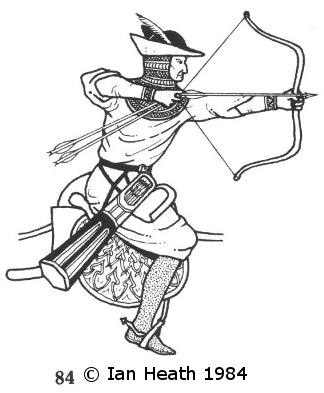
Create an Amazon Wedding Registry
CUMAN, 14th CENTURY
An extract from Armies of the Middle Ages, Volume 2by Ian Heath



84. CUMAN, 14th CENTURY
The Cumans were allied with the Bulgarians from the reign of tsars Peter and Assen (1185-96), and in the 13th century large numbers migrated from the steppes under Mongol pressure and settled along the banks of the Danube, thereafter providing a substantial part of both Bulgaria's and Hungary's armed forces as well as providing mercenaries to both the Poles (as at the Battle of Plowce against the Teutonic Knights in 1331) and the Serbians. The ruling Terter and Shishman dynasties of Bulgaria were themselves at least part-Cuman in origin, while it was a Cuman chieftain from Bessarabia in the north-east of the country who established the principality of Wallachia early in the 14th century.
This figure, from an Hungarian church fresco of c.1300, wears a short-sleeved yellow (leather?) topcoat pulled on over the head, and under it an off-white, three-quarter sleeved undercoat, a white shirt with embroidered cuffs, and brown leggings. On his head is a padded and quilted brown leather hood to which is attached a black cap with a white feather and a brown, upturned brim. Beneath the hood his hair is worn long, reaching to the shoulder-blades, which is also the way it is shown in the 'Képes Krónika' (for which see below). Indeed, 14th century sources invariably show Cumans with long hair, and though usually cleanshaven a full beard and moustache are sometimes depicted. Certainly in the late-13th century it had been customary for Cumans to shave off the beard.
Typical Cuman arms comprised composite bow, sabre, mace, and javelins. Lassoes may have also continued to be carried, but I have found no evidence of this. Shields where carried were always small and usually round, or occasionally almond-shaped.
The 'Képes Krónika' also includes Cumans (see below, figure 86), plus Bulgarians who are virtually identical to this figure. For earlier Cumans see Armies of Feudal Europe.